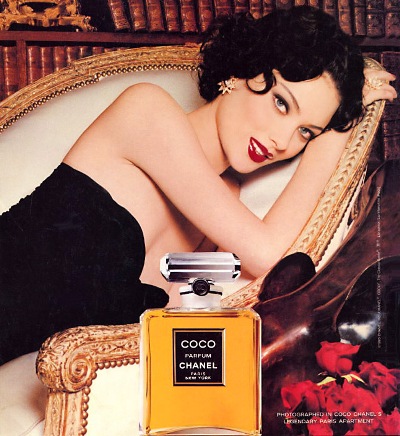Chanel Coco : Perfume Review – Bois de Jasmin
I might as well admit it, I originally disliked Chanel Coco. I will be up front about that because now I won’t be separated from it. Coco is a good case for retesting a fragrance: more compliments have come my way with Coco than with any other fragrance. Although created almost 30 years ago in 1984, Coco is far from being dated. It is an outgoing, definite statement scent, not a wallflower. It is a fragrance from the time when women adopted a signature perfume as bold style accessories. Consider Coco an adornment, a piece of jewelry, the finishing touch.

Classic Chanel scents reveal themselves through mists of aldehydes that always to my nose make a Chanel perfume smell high concept. They are tailored even when they are meant to be sexy, as is the case with Coco. The top notes are bright and brassy with ripe, fruity aldehydes, mandarin peel, and macerated raisins. These notes ignite as if flambéed.
A whiff of sweet liqueur fumes might remind some of a flambéed dessert involving raisins and oranges. These burn off quickly and disappear into a sensational floral heart composed of carnation, jasmine, and dried rose petal. And those spices! The clove and cinnamon sizzle…politely. Beneath, amber begins to radiate and glow. It is sweetly and not overly spicy, with a thin hint of leather.
Coco was launched at the time when Yves Saint Laurent Opium, Estée Lauder Cinnabar, KL were the popular trend in the so-called Oriental fragrances. These opulent perfumes breathe a rush of hot spice over roses, carnations, vanilla, tonka bean, and amber. They are intense perfumes that rode the disco era into the Big Eighties.
Coco was the last of these scents, coming seven years after Opium and not, like Cinnabar (1978) or KL (1982), traveling Opium’s South China Sea trade route. Although taking cues from the citrus opening and central carnation accord of Opium and its sister scents, Coco confronted the trend with a wetter, fruitier approach and something—in EDT—burnished and metallic. Instantly, Coco made KL and Cinnabar seem like pressured conformists, while Coco finished off the trend with an elegance encrusted with Big Eighties gilt.
I have tried Coco in all its permutations, including a superlative dry-oil spray that is now long discontinued. Somehow, over the years, the distance between it and me disintegrated and it is now my winter staple, especially around Christmas when colder weather causes its ambery notes to melt and warm on the skin. Its lasting power is legendary—a spritz lasts a day and beyond.
I’ve read comments about Coco that would have it being a beautiful relic of a vanished age, a fragrant documentary of the Big Eighties. One dab of the parfum—it glows—will dispel that notion. The drydown is impossibly rich and alluring, with hints of leather and labdanum smoothed around the corners. Coco, unlike the other Orientals of its era, is a wordless scent. You simply stop and stare at its beauty.






